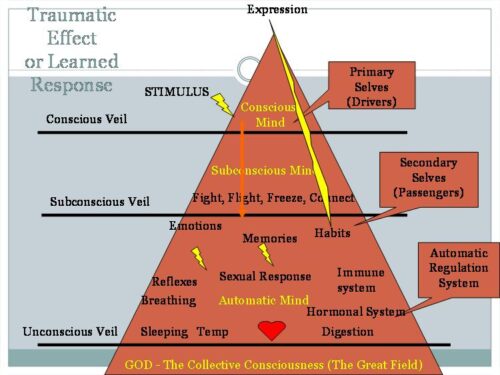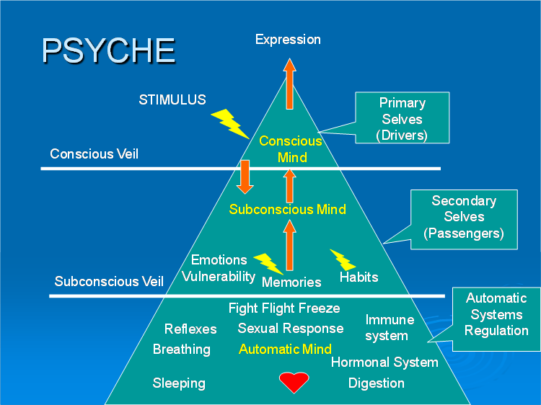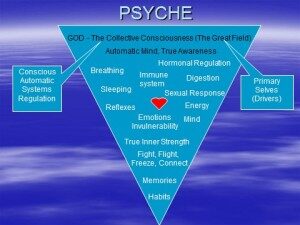The Art of Inner Suppression in Relation to Experiences of Trauma

Children who grow up in a psycho traumatic environment develop behaviour patterns that are driven by:
- Fear,
- Anger,
- Incredible sadness, and
- Emotional pain.
As these children grow into adults, they seek out ways of coping with (avoiding) their intensive unstable, and uncomfortable experiences as they recall these challenging events.
The incredible sadness and perceptions of pain become too much to bear and these children, given no other choice at the time, learn to suppress these memories. On a physical level this is a process of re-routing these memories beneath the conscious veil into the amygdala, that unconscious place, the gate keeper to our body’s sensory system and monitor of all our automatic functions, e.g. breathing, heart rate, fight/flight/freeze response, body temperature etc.
These children find ways of keeping these difficult memories and pain associated with them suppressed into the basements of their mind.
In so doing they block out their access to the super-conscious mind, that space of unconditional love, thus creating a void, or a hunger, for love. Form here a maze of “sub-personalities” or “aspects” of self are created.
Some will turn to ‘pleasure addictions’ creating such aspects as alcohol, drugs, or sex to attempt to fulfill the emptiness.
Others will turn to ‘pain addictions’ such as cutting, burning, angering, depressing, putting themselves at risk with reckless driving, creating pain and suffering within relationships, and so forth.
Self-destructive behaviours damage, and eventually destroy, the good in their lives. In time, they are left alone and hurting in the borderline zone.
The Existential ParadoxThese ‘suppressed aspects’ are literally unavailable for these children to utilise in their decision making processes and as they are now housed in the ‘automatic’ part of their minds, every time they are ‘triggered’ they fire with energy and ‘trigger’ all of the automatic system that are housed there too. e.g. breathing increases (or breath is held), heart rate increases (or skips a beat or two), the body flushes (or chills).
This image shows a surreal model of how our psyche can be easily conceived. This model shows our emotions, vulnerability, memories and habits all being available to us in our ‘sub-conscious’ mind and able to be used in making decisions in relation to how we might react to a given stimuli. The amygdala is content looking after all the automatic processes of our body.

This model on the next page shows our emotions as being suppressed or re-wired into our amygdala (automatic mind) as a result of experience of extreme interpersonal trauma such as abuse, sexual abuse, neglect or environmental trauma such as earthquake, tsunami, motor vehicle accident, electric shock, etc.
This suppression has an advantage in that we rarely or no longer experience this emotional pain and difficulty, or the memories associated with it, as it is housed in our ‘un-conscious’ mind.
The disadvantage is that when these emotions and memories are ‘triggered’ we are not aware of this, as it is happening on an un-conscious level, and the firing of these emotions and memories causes all of our automatic system to fire. This firing that is happening (for reasons unknown and un-conscious) is very unsettling for the sub-conscious mind and also the conscious mind and then the body.
The fear of what is happening in the body re-triggers the emotions and memories, re-firing the automatic system again and again. This becomes a vicious and self-destructive cycle, for which there is no obvious cause to be found other than projection, blaming our external environment. We judge our environment and others as being the cause of this anxiety and react according to our learned, automatic reflex responses, with defensiveness.
The effect on this ‘traumatized’ and ‘hyper-sensitive’ person, when involved in any interaction with self or other that triggers emotional response or suppressed memories, is to experience major unsettling symptoms of anxiety attributed to fear.
This person will develop coping skills that will enable them to present well for short periods of time when necessary, e.g. attending therapy, visiting the doctor, or attending the Family Law Court hearing, but will often make what is seen to be irrational decisions as a result of not having their full emotional capacity available to then to be integrated into the decision making process. When pressed they will resort to avoiding behaviour e.g. angering and abusing (fight response), distancing or leaving the scene (flight response), depressing dissociating or zoning out (freeze response).
“Extending the procedures of laboratory studies of aggressive behaviour, child abuse investigators measured abusive parents’ emotional reactivity to difficult behaviour.”
“Frodi and Lamb (1980) showed videotaped scenes of smiling and crying infants to abusive subjects and matched controls. In response to infant cries and smiles, abusive subjects evidenced greater physiological arousal (i.e., increased skin conductance, blood pressure, and heart rate) and reported more negative affect (i.e., more annoyance, and indifference and less sympathy) to both the crying and smiling infant scenes.” (Wolfe 1999)
“That Explains it: Teen Brains Not Connected,” (Boyd 2006)
“Researchers have uncovered why teenagers can be so difficult to live with, as ROBERT BOYD explains:
SCIENTISTS are gaining new insights into remarkable changes in teenagers’ brains which may help explain why the teen years are so hard on young people — and their parents. From ages 11 to 14, a young person loses a substantial fraction of the connections between cells in the part of the brain that enable him or her to think clearly and make good decisions. Other sources have shown this process ‘Brain Shee’ to be ongoing until at least 28 years of age and possibly beyond.This loss is a vital part of growing up. It clears out, or ‘prunes,’ unneeded wiring to make way for more efficient information-processing in adults.
Ineffective or weak connections are pruned in much the same way a gardener would prune a tree or bush, giving the plant the desired ‘shape,’ University of California-Berkeley professor of child development Alison Gopnik explained.
The pruning “appears to follow the principle of use-it-or-lose-it,” Maryland National Institute of Mental Health child development expert Jay Giedd said. “Neural connections or synapses that get exercised are retained, while those that don’t are lost.”
Just like muscles that are not being used, they will atrophy or waste away, especially as a result of the degeneration of cells, or become vestigial during evolution.
Like teenage pimples and body hair, changes in the head can be upsetting.
“It certainly seems possible normal adolescents who are experiencing these brain changes can react emotionally,” University of California-Davis Sleep Research Laboratory neuroscientist Ian Campbell said.
“Girls typically start pruning their brain cells about a year before boys, but the loss is the same.” Mr. Campbell said.
To figure out why teenagers are often moody, un-cooperative and irresponsible, scientists made images of their brains. Their tools included electroencephalograms, which record brain waves, and magnetic resonance imaging, which measures activity in various regions of the brain.
“In the past decade, brain changes in adolescence have become the subject of intensive research,” Mr. Campbell said.
“He and a colleague at the University of California-Davis, psychiatrist Irwin Feinberg, attached EEG recorders to the skulls of two groups of children, 9-11 year old’s and 12-14 year old’s, while they slept. The devices showed that the brain waves were 25 percent weaker in the older children than in the younger ones, the scientists.” Reported in the December issue of the American Journal of Physiology.
These waves are produced by electrical vibrations in brain cells, or neurons. The more neurons vibrate in concert, the stronger the wave.
Mr. Campbell compared the effect to “crowd noise within a stadium. When all the members of the crowd yell together, the noise is very loud.” Similarly, in the brain,” he said, “The intensity is strongly affected by the number of neurons oscillating in unison.”
“Synaptic pruning is a good thing. It brings about an improvement in speed in information-processing and a greater ability to build the long neuronal chains required for complex problem-solving,” he said. “There are situations in which less is more.”
However, the loss of synapses makes it much harder for an adult to learn a new language without a foreign accent or to achieve first-class athletic or musical skills, but they can be recreated!
According to Professor Gopnik’s book The Scientist in the Crib, “Each neuron in the cerebral cortex, the front part of the brain, where higher-level thinking is centered, has about 2500 connections, known as synapses, at birth. By the age of two or three, the number jumps to about 15,000 synapses per neuron. As a result of synaptic pruning, the average adult brain has only half that number. Alzheimer’s patients have even fewer.”
Other crucial changes occur in the teenage brain parallel with pruning. According to Jay Giedd, “A major rearrangement of brain structure and function takes place during early adolescence.” Regions that specialise in language, for example, grow rapidly until about age 13 and then slow down.
“The frontal lobes of the brain, which are responsible for high-level reasoning and decision-making, aren’t fully mature until adulthood, around the early 20s,” according to Deborah Yurgelun-Todd, a neuroscientist at Harvard University brain imaging centre.
“Adolescents are more prone to react with gut instinct when they process emotions,” Ms Yurgelun-Todd said.“But as they mature into early adulthood, they are more able to temper their gut reactions with reasoned responses.
”If the synaptic links to sub-conscious emotional functioning are not used they become physically deleted! Where as, the new synaptic links to the amygdala established as a result of trauma and/or neglect are used more frequently, and they become coated with a sticky substance that supports impulses to travel at ten times the normal rate or by reflex.
An experience of traumatic affect is intensified when:
- There is no Instructor to guide us and keep us safe during or immediately after the experience of risk
- Or when those who do guide us, and with whom we have felt safe, become the source of that risk, or
- When those we trust fail to believe our story of trauma
The availability of caring nurturing support with unconditional empathy will reduce the effects of this traumatic experience or experiences over time and eventually enable the emotional process to be re-wired, surfacing from the unconscious into the sub-conscious as it becomes tolerable, once again becoming available for use in our decision making processes and awareness.

We live our lives upside down. Just imagine living life from our ‘Super-Conscious’ level of being. To have all of the veils fall away, to have every aspect that we have ever created within us open and available to our super conscious mind…to be able to process information and data thousands of times faster that we have previously imagined with a greater degree of accuracy… This level of consciousness is available, thousands of people have found it, and thousands can not be wrong!
In order to access this level of consciousness, the needs of the traumatized individual showing symptoms of Borderline Personality Disorder (BPD), Post Traumatic Stress Disorder (PTSD), Antisocial Disorder, Attachment Disorder, and in fact all ‘mental illnesses’ are:
- Unconditional love and empathy.
- Unconditional support (being aware that these items will continue to trigger the unconscious firing but having the ability to gently point this out)
- Personal one on one therapy (with a therapist skilled in the area of emotional suppression)
- Group Therapy with Dialectical Behaviour Therapy (Lineham 1993)
- Family Therapy to deliver skills and understanding to close family and personal friends so that the environment may change.
- Everyone involved will benefit from some Psycic Education presented by persons who have a profound understanding of the process of suppression.
- The availability of a support advocate when making life changing decisions, e.g. Family Court matters, who can speak and show consideration on behalf of the suppressed emotion, as when it comes to emotional processing, it is not a matter of won’t – these processes are physically unavailable – it’s a case of can’t!
- This eclectic approach has been proven to have beneficial results, often enabling the person to experience emotional processing within a short space of time (average 6 months with my participants)
“Your whole mind is an amazing instrument. Its powers are awesome and when you explore your mind, what is in there will stun you. And the beauty of it is that it is entirely under your control. It will need your constant attention to bring these latent abilities and potentials to full fruition, but it is worth it because inside you right now are undreamed of powers of intelligence, mastery and faculties of creativity that are all lying dormant. It is your choice to activate them or leave them asleep.” (Rowland, M. D. 1993)
Imagine swimming in a beautiful Barrier Reef location enjoying all of the coral, fishes and shimmering light and team this with beautiful relaxing music. What a pleasure this life experience would be.
Now imagine the same scene with the Theme from Jaws playing in the background. What do you notice now, what does this feel like for you? Imagine if you were to live your whole life listening to this theme ….
Always hyper alert….hyper vigilant….everything coloured with this shady haze….
If your life is like this, get help now! counsellingfrasercoast.au/start
References:
American Psychiatric Association, 1994, DSM-IV, Library of Congress, Washington, DC.
Santoro PhD, J,1997, The Angry Heart, MJF Books, New York
Boyd, Robert, 2006, That Explains it: Teen Brains Not Connected, The Daily Telegraph (034, Fri 22 Dec 2006) Edition: 1 – State
David A Wolfe, 1999, Implications for Child Development and Psychopathy 2nd Edition, Sage Publications London Pgs 80-100
Middleton, W, Associate Professor, 2006, Understanding Childhood Trauma & Its Adult Sequelae, Seminar given for the Australian Society of Traumatic Stress Studies, Launceston, Tasmania.
Kreisman, Dr. Jerold J & Straus,Hal. 2002, Sometimes I Act Crazy, John Wiley & Sons Inc. 111 River Street, Hoboken, New Jersey, 07030, Ph. (201) 748 6011, Fax (201) 748 6008. www.wiley.com
Linehan, Dr. Marsha 1993,Cognitive Behavioural Treatment of Borderline Personality Disorder. The Guilford Press, 72 Spring Street, New York, NY 10012
Rowland M.D. 1993, Absolute Happiness, Self Communications Pty. Ltd. PO Box 100 Bellingen, NSW,2454
Santoro PhD, J,1997, The Angry Heart, MJF Books, New York
Dr. Hal Stone, & Dr. Sidra Stone, 1989, Embracing our Selves: The Voice Dialogue Training Manual, Nataraj Publishing/New World Library, Novato, CA. http://delos-inc.com/index.htm
Dr. Hal Stone & Dr. SidraStone , 1989, The Mendocino Video Series, Embracing Our Selves, http://delos-inc.com/index.htm
A Course in Miracles, Helen Schukman & Bill Thetfod, https://acim.house/
